Picture a creature that has been navigating the world’s oceans for millions of years, surviving and adapting through countless challenges.
The loggerhead sea turtle, known for its strong shell and distinctively large head, this ancient marine creature has an intriguing behavioral trait known as “natal homing.” With an uncanny ability to navigate back to its birthplace, the Loggerhead Sea Turtle embarks on epic journeys spanning thousands of miles across the vast ocean.
Loggerhead sea turtles are known for their remarkable nesting behavior. Every few years, female Loggerheads return to their birthplace to lay their eggs. They meticulously dig nests in the sandy beaches under the moonlit sky, ensuring a haven for their offspring.
This nesting ritual is a true marvel of nature, as these gentle giants overcome numerous obstacles to ensure the survival of future generations.
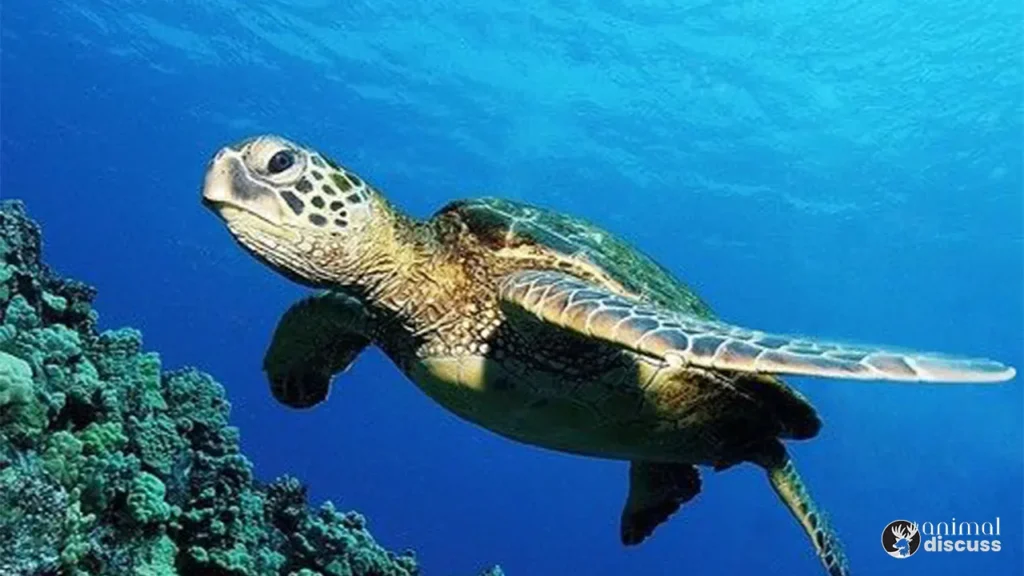
Let us embark on a journey to explore the captivating world of Loggerhead Sea Turtles, understanding their unique behaviors, and taking actions to ensure their continued existence. Together, we can make a difference and safeguard these incredible creatures for generations to come.
A Short Overview Of Different Behavioral Traits Of Loggerhead Sea Turtles
It could be excellent to provide a brief outline of hawksbill sea turtles behavioral facts before evaluating them in order to have a rapid knowledge of their way of life.
| Behavioral Traits | Key Facts – Description |
|---|---|
| Growing Habits | • Rapid growth • Slow maturation |
| Feeding Habits | • Omnivorous • Hard-shelled prey |
| Breeding Habits | • Nesting • Competition • Hatchling emergence |
| Migration Patterns | • Long-distance migrations • Precise navigation |
| Ecological Adaptations | • Strong shell • Salt glands • Buoyancy |
| Aggression and Territorial Habits | • Mating competition • Aggressive encounters |
| Social Dynamics | • Solitary • Nesting aggregations • Emergence events • Safety in numbers |
If you want to know more details about “loggerhead sea turtle“, check out.
Why Do Loggerhead Sea Turtles Behave Significantly?
Loggerhead Sea Turtles are fascinating creatures known for their significant behavioral patterns. These behaviors are influenced by various factors, contributing to their survival and overall well-being.
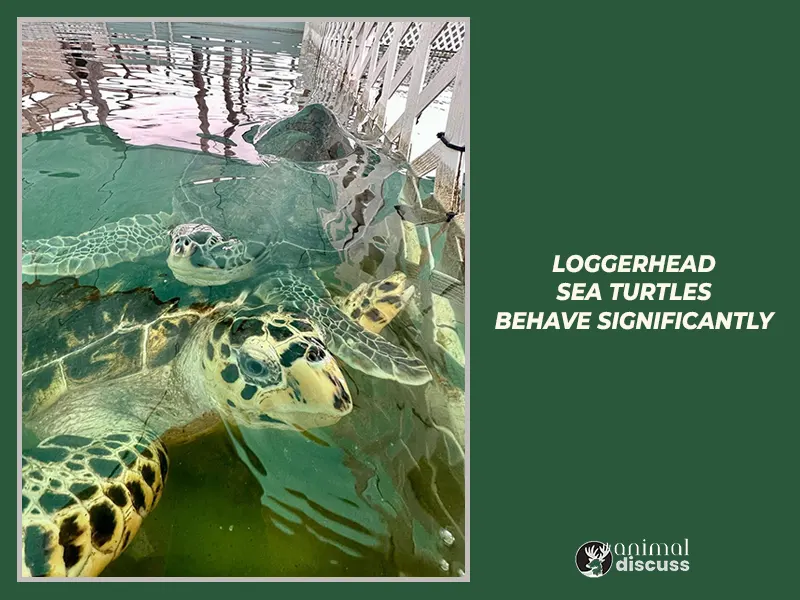
Let us explore some of the key reasons why Loggerhead Sea Turtles behave in distinct ways:
Adaptation to Their Environment:
Due to their maritime physiology, Loggerhead Sea Turtles behave differently. Swimming and diving are their strengths, adjusting to different water temperatures.
Finding Food:
Loggerhead Sea Turtles need unique foraging habits to survive. Their powerful jaws shatter shells and allow them to eat bottom-dwelling invertebrates. Their acute sense of smell helps them find food, making hunting more effective.
Breeding and Nesting:
Loggerhead Sea Turtles nest intricately for reproduction. These turtles instinctively lay eggs on their birth beaches.
They carefully choose nesting places and carefully bury their eggs in the sand for protection. Loggerhead Sea Turtles’ nesting behavior shows their ability to protect their young, emphasizing the importance of these rituals.
Migratory Patterns:
Loggerhead Sea Turtles’ remarkable migratory habits help them survive. Turtles span huge oceans on long-distance migrations. They use Earth’s magnetic fields to navigate, showing remarkable directionality.
Interactions with Other Species:
Loggerhead Sea Turtles avoid predators, form symbiotic partnerships, and maintain marine ecological bal ance. These interactions demonstrate their importance in marine biodiversity and environmental health.
By studying and conserving their behaviors, we can contribute to their long-term survival and the preservation of our marine environments.
Growing Habits: Structural And Physical Adaptations
Loggerhead Sea Turtles showcase remarkable growth habits and possess unique structural and physical adaptations that contribute to their survival in the marine ecosystem. Their extraordinary physical traits help Loggerhead Sea Turtles survive in marine habitats.
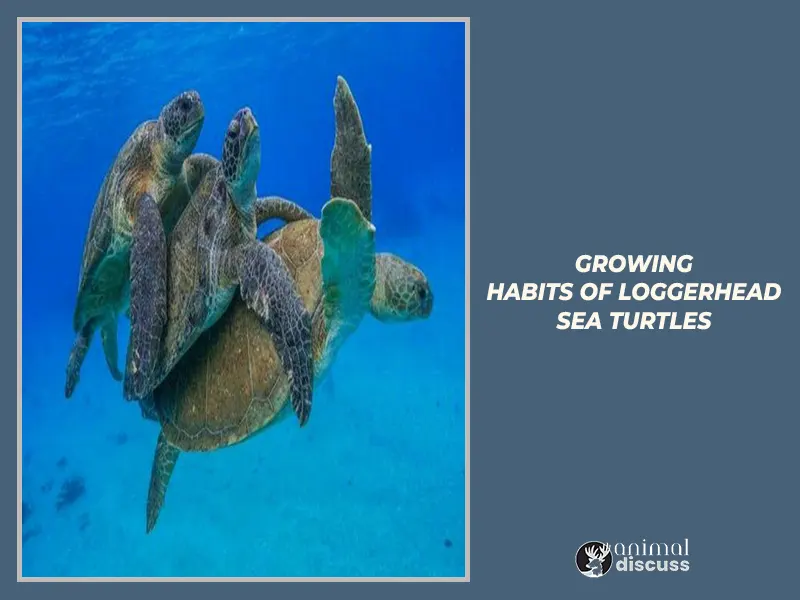
Various features demonstrate their evolutionary adaptations, allowing them to thrive in varied aquatic settings. Let us explore some key facts about their growth and adaptations:
Physical Growth Structure:
Newborn Babies: Hatchling Loggerhead Sea Turtles travel dangerously by instinct. They use instinct to discover the ocean with their eyes closed. These 20-30-gram hatchlings are 2-3 inches long and feature light-colored shells.
7 Days to 14 Days: Loggerhead Sea Turtles age and have distinct carapace patterns, allowing scientists and researchers to identify individuals. Heads grow slightly larger than bodies as they develop. As they grow, these turtles emit chirping sounds.
21 to 30 Days: Loggerhead Sea Turtles’ carapace coloration develops unique patterns as they grow. The opening of their eyes allows them to see and interact with their surroundings, which is vital to their survival. These juvenile turtles change physically as they reach 3–4 inches.
30 to 42 Days: During this time, Loggerhead Sea Turtles are more active and curious. They learn to swim and play in the water. They weigh 60–70 grammes and measure 4-5 inches at this point.
These modifications show their rising physical abilities and curiosity as they adapt to the aquatic world and learn survival strategies.
2 to 3 Months: Loggerhead Sea Turtles’ transition from mother’s milk to solid food is a major developmental milestone. This food change gives them nourishment and energy to flourish. They improve their swimming skills, helping them adapt to the ocean.
4 to 6 Months: They become self-sufficient at this stage. They’ve reached physiological adulthood with a fully functioning digestive system and teeth. They grow 8-10 inches and gain weight.
9 to 12 Months: They enter adulthood when they reach sexual maturity. This is when their physical growth slows and they develop all the traits needed for reproduction. They help their species by nesting and reproducing.
Growth Between 1-5 Years: Loggerhead Sea Turtles develop in length and weight at this time. Their usual length is 60-90 cm (2-3 ft) by age 5. Their carapace thickens and strengthens, protecting them. These changes indicate their maturation, giving them the physical traits needed for marine survival.
Growth Between 5-10 Years: Loggerhead Sea Turtles grow slower at this stage. Despite the slower growth, they average 90-110 cm (3-3.5 feet) long and heavy. During this phase, their carapace scutes fully form, protecting them. These adaptations give them the power and resilience to flourish in maritime environments as they mature.
Adult Growth: After reaching adulthood, Loggerhead Sea Turtles grow much slower. The Average length of their adult is 90-110 cm (3-3.5 ft) and weight is 135-180 kg.
In this period, their carapace fully develops, providing good protection. These traits indicate maturity and give them the physical traits needed for marine survival.
As they mature, their bodies become better suited for navigating the ocean, finding food, and surviving various challenges.
Physical Differences Among Common Species Of Loggerhead Sea Turtles
The Loggerhead Sea Turtle and its various species display distinctive physical differences that set them apart.
Let’s explore the key variations among some of the commonly known species:
| Species | Location | Size | Height | Weight | Top Speed |
|---|---|---|---|---|---|
| Kemp’s Ridley Sea Turtle | Gulf of Mexico | 1.5-2 ft | 1-1.5 ft | 75-100 lbs | 1-2 mph |
| Olive Ridley Sea Turtle | Tropical regions | 2-2.5 ft | 1-1.5 ft | 80-110 lbs | 1-2 mph |
| Flatback Sea Turtle | Australia | 2-3 ft | 1-1.5 ft | 150-200 lbs | 1-2 mph |
| Hawksbill Sea Turtle | Tropical regions | 2-3 ft | 2-2.5 ft | 100-200 lbs | 1-2 mph |
These are some of the common species of Loggerhead Sea Turtles with their respective physical differences. Each species has its unique characteristics in terms of size, height, weight, and top speed, while all share similar traits that define Loggerhead Sea Turtles as a whole.
Feeding Habits Of Loggerhead Sea Turtles
Feeding habits play a crucial role in the life of Loggerhead Sea Turtles as they are vital for their survival and overall health.
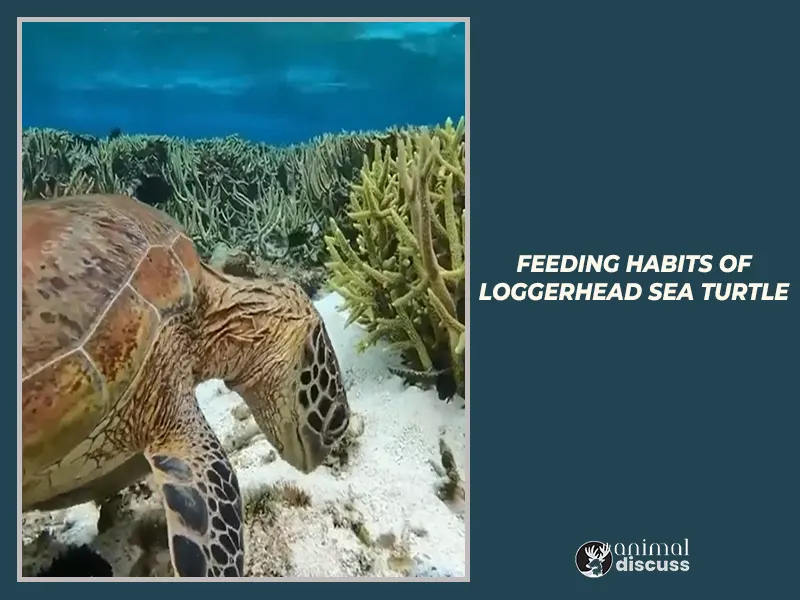
Let’s explore the fascinating feeding behaviors of these remarkable creatures:
Feeding Habits of Adult Loggerhead Sea Turtles:
Marine ecosystems depend on adult Loggerhead Sea Turtles’ flexible and opportunistic feeding approach. They eat a variety of invertebrates, mostly crustaceans, mollusks, and jellyfish.
They break shells and exoskeletons to get nutrition using their powerful jaws. Adaptable loggerheads feed on crabs, prawns, smaller fish and squid from the ocean floor.
They find prey using their front flippers to dig buried creatures and keen vision and smell. Loggerhead Sea Turtles maintain marine food webs by controlling prey numbers, especially jellyfish.
Their eating patterns and habitat are disrupted by plastic waste and climate change. Preserving these complex eating habits emphasizes the need to reduce human impact and protect marine habitats.
Feeding Habits of Loggerhead Sea Turtle Cubs:
The dietary habits of juvenile Loggerhead Sea turtles differ from those of adults. As hatchlings, their main sources of protection and nourishment are drifting seaweed, especially sargassum, and floating creatures. The foundation of the food of the baby turtles is made up of algae and tiny invertebrates found in this seaweed.
The larvae of fish, tiny crustaceans, and other microscopic invertebrates are the cubs’ main sources of food inside the Sargassum mats.
As they take use of the variety of food sources found in their drifting habitats, their feeding behavior is highly opportunistic, demonstrating their adaptability and ingenuity during this critical period of their life cycle.
The feeding habits of adult and cub Loggerhead Sea Turtles showcase their adaptability and resourcefulness in finding sustenance within their respective life stages.
Mating (Breeding) And Migration Patterns
Mating (Breeding) Habits:
The process of breeding in Loggerhead Sea Turtles is characterized by variation in both timing and location among various populations. In their courtship rituals, male loggerhead turtles use their flippers and tails to entice females.
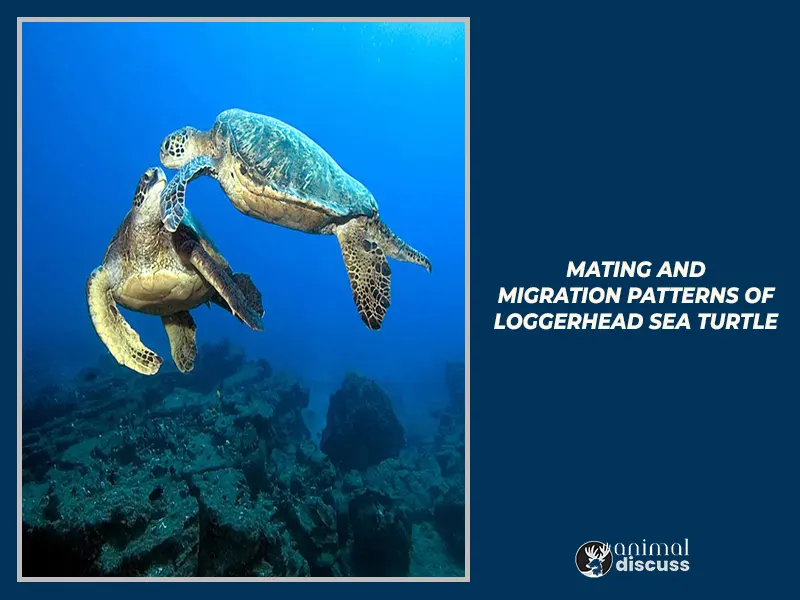
The female Loggerhead Sea Turtle migrates to the nesting beach to lay her eggs after a successful mating process. She excavates a hole in the sand with her back flippers and lays a clutch of one hundred to twelve-six eggs.
After carefully nurturing the eggs in the nest and covering it with sand, the female leaves for the ocean.
Because it protects and nurtures their young in their natural environment, the complex nesting process is vital to the existence of Loggerhead Sea Turtles.
Migration Patterns:
When migrating thousands of kilometers between their eating and hatching grounds, loggerhead sea turtles display amazing patterns. After nesting, female Loggerheads return to their feeding grounds, which can be found in a variety of coastal areas.
Even young Loggerheads engage in lengthy migrations, frequently taking rides on ocean currents that provide them with food and shelter while they travel.
These long journeys are necessary for the Loggerhead Sea Turtle’s life cycle because they give them access to appropriate feeding and breeding environments. They also demonstrate the turtle’s resilience and skill at navigating the vast ocean.
The mating (breeding) habits and migration patterns of Loggerhead Sea Turtles showcase their remarkable navigational abilities and their importance in maintaining population connectivity across vast oceanic regions.
Ecological Adaptation
Loggerhead sea turtles have developed various ecological adaptations that enable them to thrive in their marine environment. Here are some notable ecological adaptations of loggerhead sea turtles:
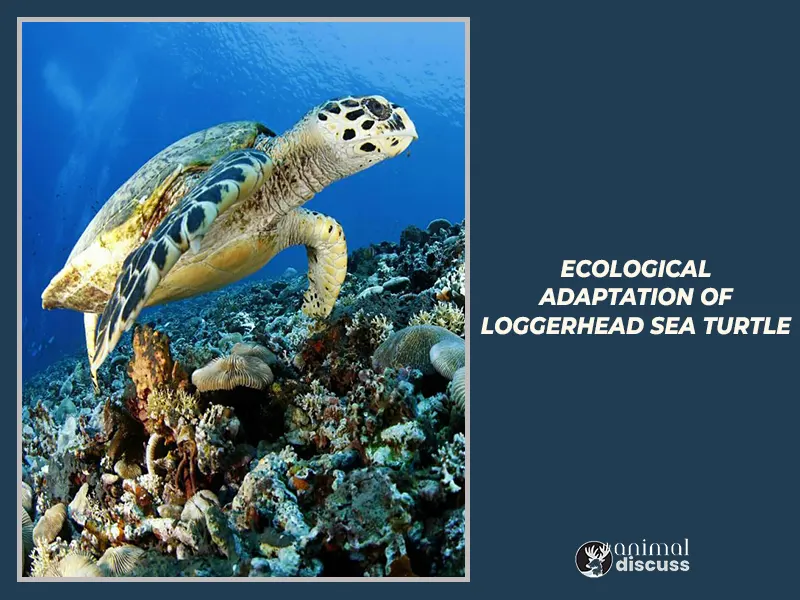
- 01. Shell Structure: The loggerhead sea turtle’s strong, bony shell acts as a key barrier, providing defence against physical harm and predators. Furthermore, the turtles’ ability to modulate their depth in the water is made possible by the robust carapace’s vital role in controlling buoyancy.
- 02. Flippers and Swimming Adaptations: During their migrations, loggerhead sea turtles are able to travel great distances thanks to the careful tuning of their flippers. This unique adaption, along with their muscular mass and streamlined body form, greatly increases their swimming efficiency.
- 03. Salt Glands and Osmoregulation: In order to adapt to their maritime environment, loggerhead sea turtles have developed specialized salt glands. We need these glands to keep our salt and water levels balanced. This adaptation helps loggerhead sea turtles thrive in their saltwater home and maintain their internal equilibrium as environmental challenges arise.
- 04. Dive Adaptations: Because of their remarkable diving prowess, loggerhead sea turtles are able to go to enormous depths in pursuit of food. Their potential to stay underwater for extended periods of time is enhanced by their streamlined body structure and aptitude to store oxygen in their tissues.
Loggerhead Sea Turtles’ Role In Ecosystem
Keystone Species:
Loggerhead sea turtles are marine ecological keystones. Their eating habits control jellyfish and other invertebrates, keeping them from overrunning and damaging the ecology. Loggerhead sea turtles help maintain ocean ecology by managing these populations.
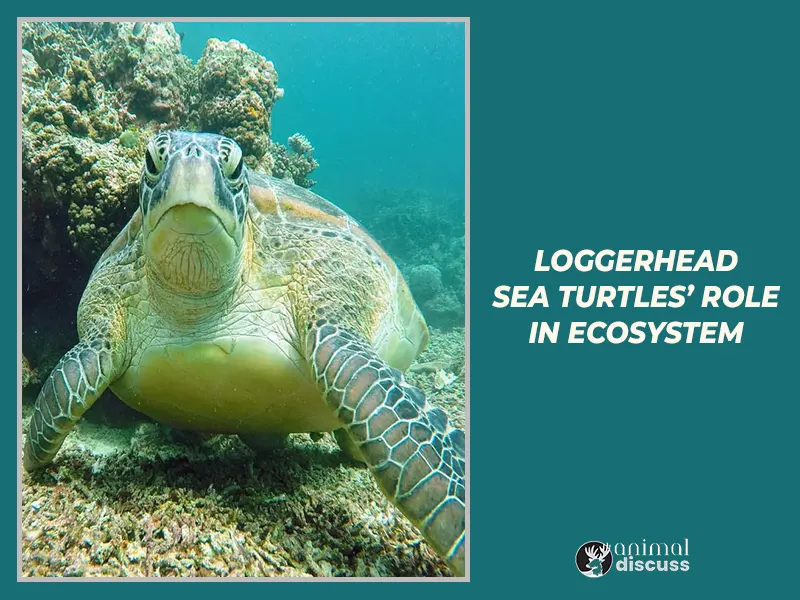
Beach Ecosystem:
Loggerhead sea turtle nesting affects beach ecosystems. They make little trenches in the sand while carefully digging nests and laying eggs. This simple effort improves the environment by aerating the beach. These pits oxygenate the sandy shore, helping beach-dependent creatures
Nutrient Cycling:
Loggerhead sea turtles are crucial to marine nutrient cycle. By eating marine species, they collect nutrients and release them into the ocean through faces. This mechanism improves marine nutrient balance, boosting aquatic organism growth and ocean ecology.
Overall Ecosystem Resilience:
Loggerhead sea turtles are vital to marine ecosystem resiliency. They indicate a healthy ocean demonstrating its balance and energy. As environmental indicators, monitoring their numbers provides vital insights on marine ecosystem health.
Their feeding habits, nesting behavior, and role as a keystone species have far-reaching impacts on the health and resilience of coastal and oceanic environments.
Social Behavior of Loggerhead Sea Turtles
Did you know that Loggerhead Sea Turtles exhibit remarkable social behaviors that play a role in their survival and well-being?
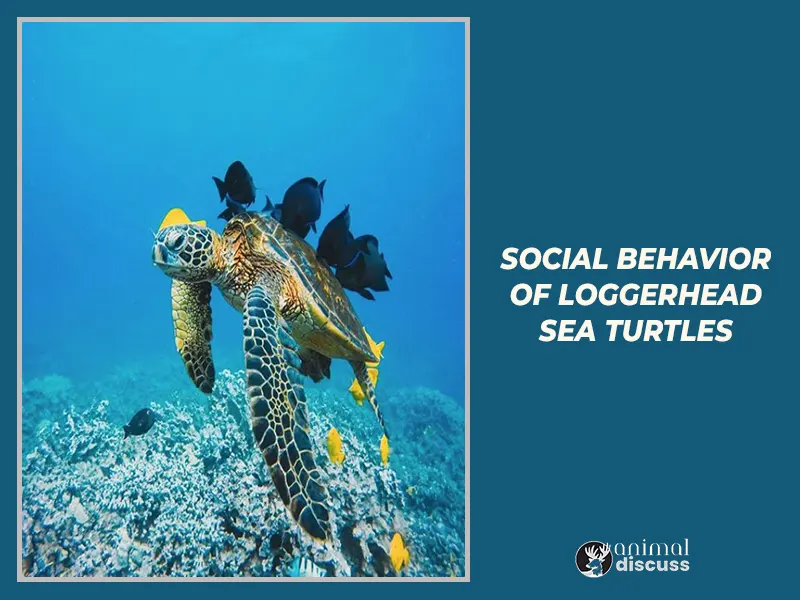
Let’s explore their social lives and uncover some intriguing facts about their social world.
01. Group Behavior:
During nesting season, female loggerhead sea turtles build arribadas on beaches to lay their eggs. This synchronized nesting shows their social character and the need of these nesting places for survival. After hatchlings emerge from their nests, they often travel to the ocean in a mass emergence, demonstrating their coordination and instincts in their dangerous trek.
02. Mating Rituals:
Courtship and male competitiveness are fascinating in loggerhead sea turtle mating behaviors. Males bite and push to establish dominance and mate with females. These competing interactions show the complexity of their social dynamics and how important these rituals are to species reproduction.
03. Orientation and Navigation:
Loggerhead sea turtles have exceptional orienting and navigational social behavior. These sea turtles can explore large maritime distances and return to their nesting grounds. This remarkable navigational capability helps them select nesting places and is vital to their species’ survival.
04. Communication:
Visual displays, tactile interactions, and vocalizations help loggerhead sea turtles communicate. During mating and nesting, their adult conversation may strengthen social bonds and facilitate reproductive behaviors, while the details are unknown.
05. Group Foraging:
Seagrass beds and coral reefs are rich in food, therefore loggerhead sea turtles form loose groups to forage. Social foraging boosts prey availability and feeding efficiency. These gatherings illustrate how they recognize and use collective advantages, demonstrating the intricacy of marine social relationships.
While they are primarily solitary creatures, they do display certain social behaviors during nesting, mating, and orientation. Understanding these social behaviors is essential for the conservation and protection of these remarkable sea turtles and their important role in maintaining the balance of marine ecosystems.
Aggression And Territorial Habits
Loggerhead sea turtles may display various forms of aggression in certain situations, which play a crucial role in their survival and reproduction.
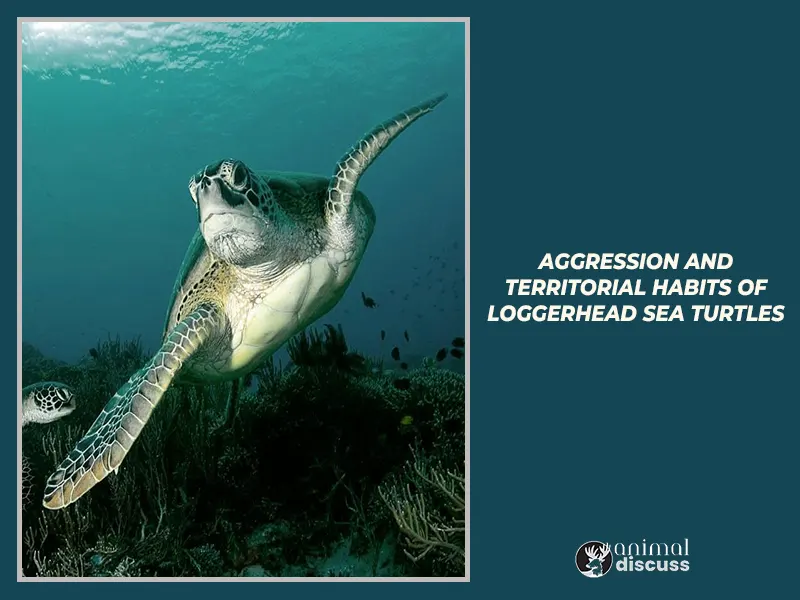
Aggression:
In breeding season, male Loggerhead Sea Turtles fight near nesting beaches to dominate. These confrontations entail head-bobbing, pushing, and biting. Aggression is typically done during breeding season to assert power and secure mating.
These strong and determined displays depict male Loggerhead Sea Turtles’ competitive courtship and drive to reproduce in the harsh maritime environment.
Territorial Habits:
The territorial behavior of loggerhead sea turtles is exhibited by their fierce defense of their homes and eating areas. They use visual signals and scent trails to mark their territories and let others know they are there.
Vulnerabilities include threats made with their mouths open and sudden lunging motions. They are guaranteed access to vital resources, like as food sources and nesting locations, thanks to their territorial defense tactic, which emphasizes how vital it is to preserve these areas for their survival.
Facts that influence different Behavioral Traits
The natural behavior of loggerhead sea turtles is influenced by various factors that shape their unique pattern.
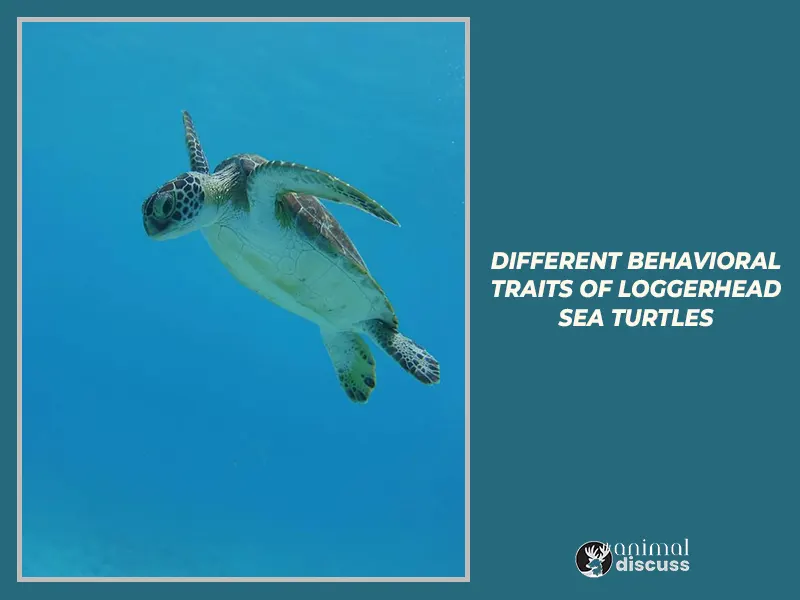
Here are some fascinating facts about the factors that play a role in their behavioral traits:
Environmental Conditions:
Loggerhead turtles adjust well to water temperature, salinity, and ocean currents. Environmental circumstances greatly affect eating, migration, and nesting.
Genetic Influences:
Loggerhead turtle behavior is shaped by genetics. Genetic differences affect nesting, foraging, and migratory tendencies in different populations.
These genetic variants help explain the varied behavioral patterns of different loggerhead turtle populations, enabling targeted conservation efforts to preserve this fascinating species.
Social Interactions:
Loggerhead turtles socialize at breeding areas and community feeding sites. Turtles mate, compete for resources, and cooperate. These social dynamics influence their breeding, feeding, and survival choices.
Human Interference:
Loggerhead turtle behavior is greatly influenced by humans. They struggle to obtain food, reproduce, and navigate due to habitat loss, pollution, and climate change.
Human Induced Facts That Change Loggerhead Sea Turtles’ Behavior
Have you considered how humans influence animal behavior, even unintentionally? Human activities such as polluting the environment, destroying habitats, and altering the climate have a great impact on the behavior of the Loggerhead Sea Turtles.
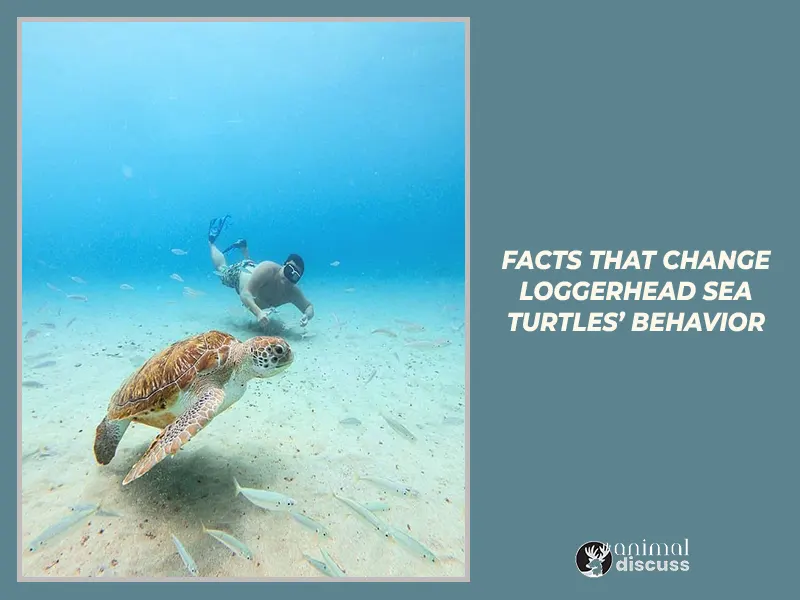
Here are several examples:
Coastal Development:
Human activities like coastal development and urbanization have degraded loggerhead turtle habitat. Buildings, highways, and beachside developments disrupt nesting locations and disorient hatchlings, altering their behavior.
Light Pollution:
Loggerhead turtles are endangered by coastal artificial illumination. Bright lights from buildings and streetlights can confuse hatchlings, which follow the moon and stars to the water. This disorientation enhances their predator vulnerability and disturbs their natural behavior.
Pollution and Marine Debris:
Loggerhead turtles are threatened by oil spills, chemical pollutants, and marine debris. Ingesting plastics and other contaminants can harm them and change their feeding habits. They also become caught in fishing gear, which hinders their movement and feeding.
Climate Change:
Loggerhead turtle behavior is greatly affected by climate change. Nesting behavior, migratory time, and prey availability can change due to rising water temperatures. These changes demonstrate the urgency of addressing climate change to preserve loggerhead turtle behavior and ecosystems.
Wildlife Trade:
Loggerhead turtle shells, flesh, and eggs are prized in some locations, making them vulnerable to the illegal wildlife trade. Poaching alters their behavior and reduces their population. This unlawful trade must be stopped immediately to protect loggerhead turtle populations and behaviors.
How to conserve Loggerhead Sea Turtles’ Behavior?
Loggerhead Sea Turtles and marine ecosystems depend on preserving their natural behavior. Conserving their behavior involves maintaining their habitats, reducing human-induced hazards, and encouraging responsible behavior.
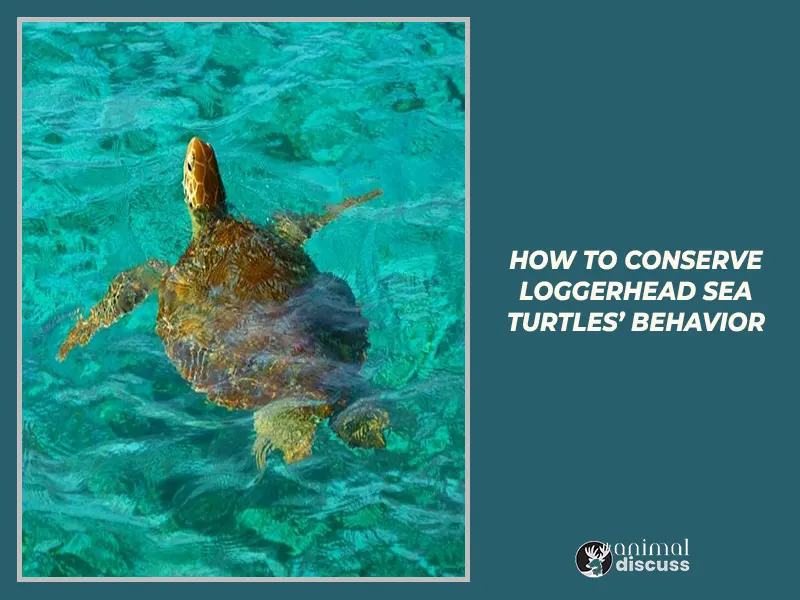
Loggerhead Sea Turtle behavior conservation involves the following:
Protect Nesting Sites:
- Implement strict regulations and enforce protected nesting areas to ensure the safety of loggerhead turtles during the nesting season.
- Monitor and manage beachfront development to minimize disturbance to nesting sites and preserve suitable nesting habitats.
Reduce Light Pollution:
- Use turtle-friendly lighting practices along coastlines, such as using low-intensity amber LED lights or shielded fixtures, to prevent disorientation of hatchlings.
- Educate coastal communities and businesses about the importance of reducing artificial lighting near nesting beaches.
Reduce Pollution:
- Raise awareness about the impact of pollution on marine ecosystems and encourage responsible waste disposal practices.
- Participate in beach clean-up initiatives to remove marine debris and prevent it from reaching the ocean.
Support Conservation Research and Education:
- Fund research projects that focus on understanding the behavior and ecology of loggerhead turtles to inform conservation strategies.
- Educate local communities, schools, and tourists about the importance of protecting loggerhead turtles and their habitats.
Numerous organizations actively advocate the preservation of these magnificent creatures and their behavior. Some of these organizations include:
- 01. Loggerhead Marinelife Center (LMC): The nonprofit organization LMC protects marine turtles and their habitats. They spread out the sea turtle conservation program by conducting research, education, and outreach.
- 02. International Sea Turtle Society (ISTS): This organization provides the sharing of information and a close communication among researchers, environmentalists, and policymakers who are working on protecting the sea turtles.
- 03. Marine Conservation Institute (MCI): The primary vision of this organization is to protect and conserve the overall health of marine ecosystems all around the globe. By carrying out various scientific study, support of specific guidelines, and interaction with the local governments, they solely strive to lessen the challenges that marine animals face, especially the loggerhead sea turtle.
Conclusion
In conclusion, the loggerhead sea turtle stands as a remarkable creature with its unique behavioral traits and adaptations. Each and every part of their activity, from their growth patterns to their eating habits, breeding practices, and migratory journeys shows a significant role in both their ability to survive as individuals and in the overall health of the marine bio-diversity.
The ability to understand and value the multiple nature of their behavioral facts, is essential to the success in all conservation attempts. We will be able to set and implement the successful conservation policies if we first detect the influential factors of their behavior and the overall threats they confront.
Let us allow ourselves to be motivated to take necessary actions as we continue to increase our understanding of the habits of loggerhead sea turtles. Together, we will become able to make a change and provide these wondrous creatures a better chance at a prosperous days in the future.
References
- https://conserveturtles.org/information-sea-turtles-loggerhead-sea-turtle/
- https://marinelife.org/research/loggerhead-sea-turtle/
- https://www.worldwildlife.org/species/loggerhead-turtle
- https://www.nationalgeographic.com/animals/reptiles/l/loggerhead-sea-turtle/

